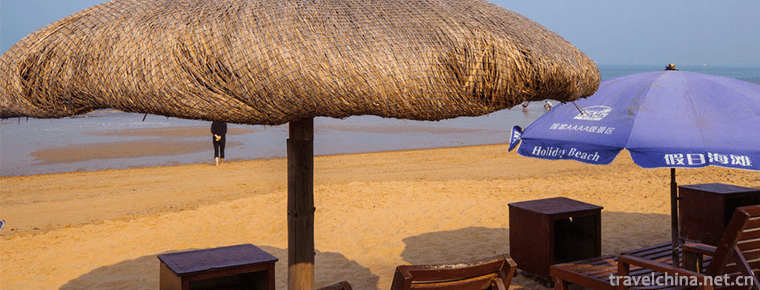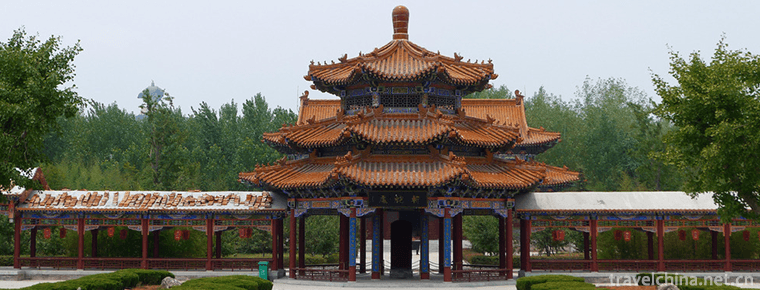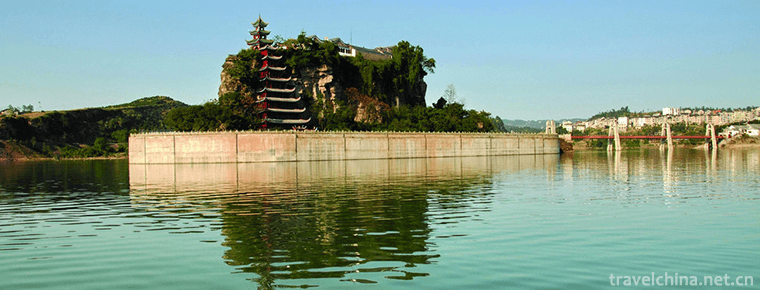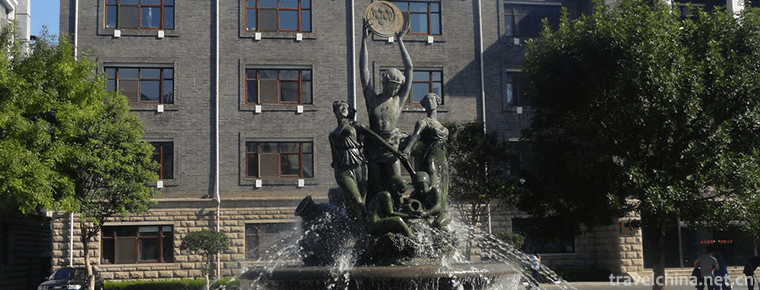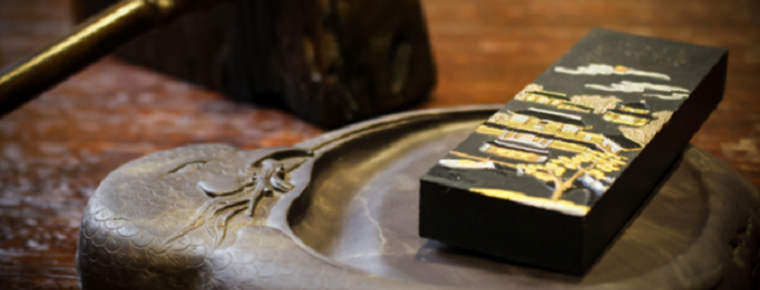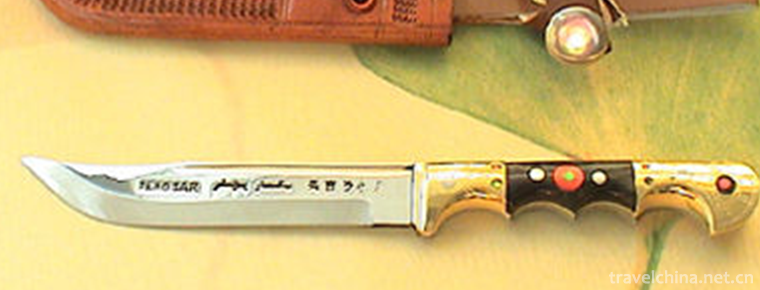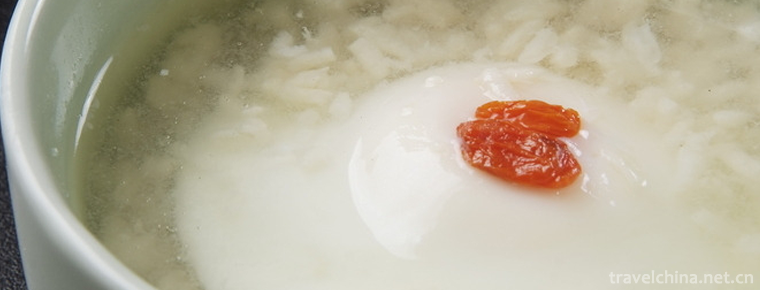Baligou Scenic Area
Baligou Scenic Area is located in the deep mountain area of Shangbali Town, Huixian County, Xinxiang City, Henan Province, 50 kilometers northwest of Xinxiang City, the southern foot of Taihang Mountain, the junction of Henan and Shanxi Provinces, with an elevation of 300 meters to 1700 meters, and a total area of 42 square kilometers. It is a typical South Taihang scenic spot. It is a national 4A-level scenic spot, a national geological park, a natural macaque reserve and a famous scenic spot in Henan Province. The top ten scenic spots favored by Henan tourists in 2005.
Baligou scenic spot gathers the essence of Taihang mountains and waters. It gathers wonders, dangers, handsome, beautiful and secluded in a valley. It is known as "the soul of Taihang, the spirit of Chinese style", and is praised as "one of the best in Asia" by landscape experts. Taihang is the place where the essence of mountains and waters are gathered. It has the hero of Mount Taihang, the danger of Mount Hua, the seclusion of Jiuzhai and Qingcheng, the beauty of Mount Huangshan and Emei. It is known as the soul of Taihang and the spirit of China.
geographical position
Baligou Scenic Area is 30 kilometers from Huixian, 50 kilometers from Xinxiang City, 120 kilometers from Zhengzhou, 160 kilometers from Luoyang City, 130 kilometers from Kaifeng City and 140 kilometers from Shaolin Temple, which is close to Zhengzhou, capital of Henan Province.
natural environment
Landforms
Baligou Scenic Area has over 95% forest coverage, 1700 plant species and 5000 atmospheric content per cubic centimeter. It is a "natural oxygen bar". The mountain body in the scenic area is a three-level cliff.
climate
The average annual temperature is 14 degrees, three-volt midsummer, spring before noon, autumn in the afternoon and early winter at night. It is very suitable for summer and summer.
Spring: Baligou in spring, everything recovers, and many branches of wild trees begin to reveal green buds. At this time, the peach garden of Taohua Bay scenic spot also begins to reveal fragrance, and the whole scenic area has a vivid and fresh image.
Summer: Baligou has a cool summer wind and abundant rainfall in this season. The scenic spot features "Baitan hundred waterfalls in succession, Tianhe waterfall in succession".
Autumn: Baligou in autumn is full of red leaves and fruitful. Persimmon, hawthorn, wild peach, apple and apricot are red stars all over the branches and red leaves in the mountains.
Winter: Ice pillars solidify from the Taihang Tianhe Falls. Natural ice pillars over 180 meters long can be seen.
It's the quietest season in Taihang.
Historical evolution
Baligou was an important activity area of primitive tribes such as Gonggong clan in ancient times.
Since the Wei and Jin Dynasties, it has become a place for good landscape people to seek seclusion and beauty. Many literati and refined scholars have come to live in seclusion or travel, leaving a lot of good stories.
Seven virtuous bamboo groves in Wei and Jin Dynasties, Wang Tong and Wang Bo in Sui and Tang Dynasties, Shao Yong in Song Dynasty, Fan Chengda and Lu You, Yuan Haoqu in Jin Dynasty, Niu Shouzhen, a famous landscape painter in Yuan Dynasty, Sun Qifeng in Qing Dynasty, and so on. The poem Shimen Mountain Waterfall, written by Sun Fang, Sun Qifeng's grandson, has become a classic work describing Baligou Waterfall.
During the Republic of China, Yuan Shikai, Xu Shichang, Feng Yuxiang and other historic celebrities had visited this place. During the Anti-Japanese War and the War of Liberation, the Taihang Mountains were important bases for the revolutionary struggle of the Eighth Route Army and the Liberation Army. Many revolutionary leaders were deeply impressed by the mountains and waters.
After the founding of the People's Republic of China, Wang Guangying and other state leaders have visited and guided here many times.
Main attractions
Overview
Baligou Scenic Area includes Taohua Bay, Hongshi River, Rhesus Monkey Area, Yuhuang Palace, Yangzhou Land and other five scenic spots. There are more than 150 scenic spots such as Mountain Guanyin, Yuhuang Palace, Mawu Goddess, Zhongshan Jiufo, Shiren Welcoming, Laozi Passage, Xiongguan Front Line, Heilongtan, Tianhe Falls and so on. Among them, Baligou Falls falls 200 meters apart, with magnificent momentum, and is known as "Taihang Tian Falls". Red Stone River is overflowing with green and red water. It is colorful and picturesque. It is known as the Taihang Tianhe River because of its elevation of 1700 meters.
Mountain Gate Plaza
Ten thousand square meters, here you can enjoy the natural and humanistic wonders of "a Bay of clear water, the confluence of two streams, three groups of ancient buildings, four peaks, five ridges surrounded".
The confluence of one bay of green water and two streams refers to the confluence of the two streams of Baligou and Xilian Valley into Phoenix Bay; the three groups of ancient buildings refer to the Han and Tang architectural complex composed of bridgehead, Erxianqiao and Shanmen service building, and the Baligou Hotel and Taihang stone house building in Ming and Qing dynasties. The three groups of ancient buildings transited from the upper strata of the times to the original natural scenery of Baligou. Four peaks are listed and surrounded by five ridges, which refer to the sleeping beauty peak, Phoenix peak, Buddha's palm peak and Lion peak around Shanmen Square and the surrounding Guanshan, Lao Yeding peak, Jiulian mountain, Baoqiao mountain and Yuping mountain. These peaks are like arches and guards, just like the five powerful men in myth who loyally defend the tranquility and solemnity of the mountain gate.
To Hongshi Scenic Spot, you can choose North Road or South Road. North Road passes through "one-line sky" or "one-step sky climbing" sightseeing elevator, and South Road passes through Baligou Trestle Road (cliff sky ladder). The zigzag iron ladder on the cliff is the trestle. Some friends will take a breath of cool air when they see it. They are afraid of it. In fact, it is very safe. Baligou Trestle Road is located 200 meters to the left of the Great Falls. It is 180 meters in length, 130 meters in vertical height and 650 steps. The trestle is a steel structure. It was built in September 2000. There are guardrails on both sides of the trestle. It is totally closed, so it is fast and safe. "One Step Sky Climbing" sightseeing elevator is located near "One Line Sky" on North Road. It is 168 meters high. It is named "One Step Sky Climbing". It means that tourists can easily step into the elevator and directly climb the top in 90 seconds. Middle-aged and elderly tourists and urban people with poor health can climb the triple cliff and enjoy the beautiful scenery of Hongshi River. There is no fear of climbing. They can also enjoy the "Stone Flower Rock" nearby. "Liu Xiuquan" and other scenic spots.
Thin strip of sky
A line of sky is a very narrow gap. In the past, villagers had a winding mountain path, which meandered and stretched like a giant dragon, hovering between the cliffs, known as the "dragon ladder". Hundreds of steps are steep and steep along the cliff. This is the only way for villagers in Baligou and villagers in Shanxi Province to go up and down in the past. On both sides of a line of sky, the walls are cut, clouds and mists are all around, along the way, there are many strange stones, precipitous and strange, and the scenery is excellent. Man walks in the primitive mountain road, sometimes bending his head and back, sometimes sticking to the wall sideways, sometimes looking up to climb, sometimes looking down at the ravines. The mountain road bends and the stone steps fluctuate, like a ribbon in the air, up and down, and now and then disappear. Standing on it, you can see a variety of strange stone scenery, a deep and unfathomable secluded canyon. Tourists walk through it and look up at the sky. They can only see a line of blue sky. So they get the name of a line of sky, which is also called "a line of Xiongguan" and "a line of long days".
Redstone River
"Hongshi River" is located on the "Huluya Cliff" of Baligou. Because the riverbed is red stone sandstone, it is called "Hongshi River". Originating from Shanxi Province, the river is 20 meters wide and 0.6 meters deep. Because of its altitude of 1500 meters, it is also called Taihang Tianhe River. The Valley is deep and the water is murmuring. The river is flowing along the smooth and scattered red slate streams. In the sunshine, such as the giant crystal board, crystal clear and bright, like rocks playing brooks, melodious. The Green River is like a precious mirror, lying between the green hills, reflecting the blue sky and white clouds, which makes people dazzling, turning back step by step, and admiring one fold and one fold. There are eight huge stones in the Red Stone River. It is said that the Eight Immortals once visited and had a rest, so they are called "Eight Immortals". People can also be "immortals" here, where they play with water, visit and take photographs as souvenirs.
Guanyin Cave
"Red Stone River" side of a natural cave, called "Guanyin Cave", also known as "Qinglong Cave", where the dog days are cool and refreshing. The Dongli spring water is continuous all the year round, transparent in color, free of impurities, odorless and contains many kinds of trace elements beneficial to health. It is sweet and delicious and suitable for drinking.
Great Falls
Baligou Waterfall is magnificent and magnificent, with a drop of 157 meters, a width of 5 meters and a maximum flow of 20. It lasts all the year round.
Route:
There are two alternative ways to visit Baligou Falls, one is the smooth road above, the other is the newly built trail. Through the parking lot, from the bottom of the ditch forward, you can see the small bridge running water, winding paths, unique flavor. There are many waterfalls at the bottom of the gully. They are five steps and one pool, ten steps and one waterfall. Panlongtan is a deep pool with many boulders and charm.
On the south side of the pond, an elm tree grows vigorously on the stone. There is also a large lacquer tree, the SAP can make paint, but toxic, can cause allergies. "Wo Niu Tan" Valley quiet gully, such as into fairyland. Towards the end of the ditch, I only heard the thunder of waterfalls, and saw a white practice falling from the sky. Its momentum was magnificent, but I did not see its face and heard its voice early. This is the main scenic spot of Baligou scenic spot - Baligou Falls. •
Baligou Falls originated from the Hongshi River, which flows from Shanxi to China at an elevation of 1500 meters. So it is also called the drop of 170 meters, the widest time is more than 20 meters, and the smallest time is 5 meters.
Pearl Spring
There is a valley on the north side of the mountain. The spring gushes out and falls from the rocks like pearls, like needles and threads, string by string, line by line, like Dendrobium pearls. It rises and falls one after another and never stops. So it is called "Pearl Spring".
Peach blossom Bay
Waterfalls and pools are connected, and the Peach Blossom Bay scenic spot is rippling with water. This scenic spot mainly includes peach blossom pool, peach blossom bay, general pool, peach blossom Bay waterfall, general pool waterfall and other beautiful scenic spots. The Peach Blossom Bay Waterfall is seen from afar. The water pool below the waterfall is called Peach Blossom Lake. On the top of the waterfall is a Peach Blossom Bay with an area of 20,000 square meters. On the right of Taohua Bay is a lush peach garden, beside which there is a very primitive Taoyuan Pavilion Hotel. Every spring season, peach blossoms are in full bloom, red and gorgeous, pollen is fragrant, the air is fragrant.
It is said that this peach forest evolved from a peach stone thrown by Dongfangshuo when he stole peaches for Emperor Wudi of Han Dynasty. Therefore, the Queen Mother also held a peach convention in Baligou for this purpose. This scene is still preserved in our Jade Palace Cultural Tour Area. On the water surface of Taohua Bay, some projects have been developed, such as flying rope, rocking bridge, bamboo raft, drifting, etc. There is also a relatively open beach where you can stop and play.
The Cave of Tidal Sound
Chaoyin Cave is a natural stone cave, in which a statue of Guanyin Bodhisattva is worshipped. Its carvings are exquisite and lifelike.
Legend has it that the water source in the cave leads directly to the South China Sea. Standing in the cave, listening attentively, it seems to hear the sound of the tides coming faintly, so it is called "Chaoyin Cave".
Another example is Guanyin's lecture on Buddhist scriptures, which is graceful and pleasant, so Chaoyin is Buddhist. According to legend, Emperor Liu Xiu of Hanguang took refuge in this cave. It was the God spring in the cave that saved him from pursuing troops. Ever since then, people have come to this cave to seek Guanyin's divine waters to save suffering, and the rumors are very effective.
The water in the cave is transparent and contains many kinds of trace elements which are beneficial to health. It is sweet and refreshing and suitable for drinking.
Sincere stone
Baligou Chengxinshi is a red sandstone with a length of 11 meters, a width of 9 meters and a thickness of about 8 meters. It's high and low, like a big red heart. Legend has it that Liu Xiu climbed to the Jade Emperor's palace and stood on the marvelous stone at that time, when the rain stopped suddenly, the "Heart Stone" blessed Liu Xiu. Liu Xiufu was busy kneeling in front of the Heart Stone to make a wish to the Great Yellow Gong: If heaven never dies in my Han family, he would come here to worship heaven and earth when he got the world.
Later, after Liu Xiu ascended the throne, he rebuilt the Jade Palace and awarded the stone as "the stone of sincerity", which was directly called "the stone of wishes" by the common people.
Since then, people have made good wishes here.
Three niche
Located under the Danbiya cliff on the west side of Shimen Reservoir, there are more than 30 niches in the concave cave. Looking at the three niches from a distance, there are actually five niches connected with each other. Abbreviated as one niche well and two niche pagodas, three niches live in Bodhisattvas.
The three niches say that there is a temple in the niche, beside which there is a holy well. The water is clear, the drought is not dry, and the flood is not overflowing.
The second niche has a brick tower of Ming Dynasty. The tower is over 10 meters high. It has a unique shape and is skillfully crafted. The existing tower is destroyed and remains.
The three niches are more comprehensive and handsome. They are inscribed "Yunfeng Temple" on the mountain gate. They were founded in the Song Dynasty. When did they rise or fall?
In the reinvention period of Jiajing in Ming Dynasty, the base site was widened. More than a dozen palaces and pavilions were built successively, and more than 30 houses were built. The original name of Yunfeng Temple was renamed Yunfeng Temple, which was rebuilt frequently. There is a hanging spring on the North bank, which is injected into the front pool of the palace, just like the Dragon spitting pearls. It is very spectacular.
Fu Xi Feng
Fuxi Peak and Nuwa Valley: It is said that after Pangu opened up the world, the heaven and the earth had just separated, and some places were still linked together. The sun, moon and stars moved unsteadily, and all living creatures were uneasy.
At this time, the great God Fuxi Nuwa stood up to "rule the heavens and the earth" and formed the pattern of the heavenly circle. Later, Fuxi deduced the Eight Diagrams to teach people to hunt and fish in the net, and was appointed as the Emperor of Heaven in charge of the East. The hill opposite Fuxi Peak, which is 1399 meters above sea level, is also the place where Fuxi went to serve in heaven. Is not the small hill around it just like the people of Li who painstakingly retained Fuxi God? ?
Nuwa Valley is facing Fuxi Peak with rhubarb niche on its back. There are fragrant scattered waterfalls flying overhead. Under it are green and clear Queen Mother's dressing pools. The image of Fuxi Goddess on the left is full of antiquity. On the right side, Nuwa Qishi suddenly rises. Trickle-by-trickle flow appears and disappears from time to time, more and more sets off the profound and distant of the Jade Palace in the thousand-year-old cave, and it seems as if it has come to the immortal world. Legend has it that this is also the place where Nuwa made people from earth.
Great imperial Shrine
Baligou Great Emperor Gong Legend: In ancient times, heaven and earth were dark and yellow, the universe was flooded and desolate, and thousands of families were extinct, leaving only Fuxi and Nuwa brothers and sisters. They grew up, in order to reproduce their offspring and create human beings, the elder brother wanted to marry his sister, but the younger sister said, "How can this be done?" We are brothers and sisters!" Unable to withstand my brother's repeated pleading, my sister had to make a plan and say, "If you catch up with me and hold me, we will get married, otherwise we can't."
So the brothers and sisters chased around a big tree. The younger sister was agile and ran fast, but the older brother could not catch up. Suddenly came up with an idea, and suddenly turned around and ran, the sister who had no defense at all, panting face to face into his brother's embrace, was tightly embraced by his brother, so they became husband and wife. But brothers and sisters are always shy when they get married. Sisters have to cover their faces with banana leaves. That's why girls have to cover their heads with cloth before they go to worship heaven and earth.
A hundred-year-old Lily tree
Legend has it that in the late Western Han Dynasty, Liu Xiu escaped from Wang Mang's pursuit, fled to Baligou, chopped the cliffs with his sword, ran out of energy, climbed under a tree, and was attacked by the mountain wind and night cold. He got sick and was rescued by Su Niang of Shangu. A strange love story happened here.
Later generations called this tree "Albizzia tree" in memory of them. In order to enable more people to conclude a happy marriage, people named it "Hao He tree for a hundred years".
Over the years, hundreds of newly married couples have come to this "100-year-old good Lily tree" every year to make a wish, to tie the knot and make a good lily.
Erxian Bridge
The Erxian Bridge in Baligou is a bridge over Qingshi Bridge across Xiliangou. The Han Dynasty Yunlong relief is carved on the railings on both sides. Erxianqiao is named after Erxianmiao on the Phoenix Ridge in front of it.
Legend has it that Liu Xiu was chased and killed by Wang Mang and escaped to Fenghuangling in Baligou. He was rescued by two girls who were treated by villagers. Wang Mang learned that the two girls were caught and asked for guilt. The two girls were chased to the cliff and fell to the cliff to commit suicide.
In order to commemorate the construction of Erxian Temple on Fenghuangling Mountain by two herb-picking girls, Liu Xiu rebuilt Erxian Golden Body in return for the two girls'help. In the early Ming Dynasty, the temple was rebuilt in Chongzhen ten years. Over the years, Erxian Temple has enjoyed a vigorous fragrance.
Chaoyanggou
In the 1960s and 1970s, the Henan Opera Chaoyanggou sang the whole country up and down, north and south. A small village in Baligou is quite similar to Chaoyanggou in drama in terms of geographical location, topography, production tools, crop cultivation, living customs and local dialects. Baligou Scenic Spot held Chaoyanggou Opera Competition here and arranged it according to the plot of Chaoyanggou. Welcome to Baligou to experience Chaoyanggou: live in Chaoyanggou village, eat Chaoyanggou rice, sing Chaoyanggou opera, do Chaoyanggou farm work, and comprehend the natural wild interest of living in the deep mountain village of Southern Taihang.
Practical information
Ticket information
Adult ticket: 80 yuan. Children under 1.2 meters are free of tickets; people over 70 years old are free of charge with relevant documents; people over 1.2-1.4 meters tall buy children's tickets for 45 yuan; students'vouchers buy students' tickets for 45 yuan; people over 60 years old with preferential treatment certificates for 45 yuan.
Best travel time
All seasons are suitable. In spring, there are many pink peach blossoms in the Peach Blossom Bay. In summer, you can play in the cool Baligou scenic spot. Autumn is suitable for viewing the human landscape, and the torrential waterfall is a scenic spot in autumn. Snow cover in winter, the "iceberg" under the waterfall is crystal clear, and the ice hanging on the cliff is scattered, which is quite different from the other three seasons.
Catering accommodation
There are many farmhouse pleasures in the scenic area, which can provide catering and accommodation services.
Traffic information
Internal traffic
transit
Xinxiang to Baligou, 8:30 a.m. and 9:30 a.m., start at Xinxiang bus station.
From 7:00 to 16:00 a.m., there is an hourly shift (8 classes) from Huojia to Baligou, which starts at Huojia Bus Station.
From Huixian to Baligou, Baiquan Bus Station starts every hour from 8:00 to 12:00 a.m.
Xinxiang Hotel has a bus to the scenic spot from 6:30 to 7:00 in the morning and a return trip from 16:30 to 17:00 in the afternoon.
Sightseeing car
There are sightseeing buses for tourists to choose in the scenic area. The ticket is 10 yuan per person (one way). The whole journey of the sightseeing buses is about 4 kilometers.
External traffic
The important cities within 600 kilometers are Beijing, Tianjin, Wuhan, Xi'an, Shijiazhuang, Taiyuan, Jinan, Hefei, Xuzhou, Baoding, Luoyang and Xiangfan. Starting from Baligou, they can reach Zhengzhou, Anyang, Jiaozuo, Hebi, Puyang and Heze in about 2 and a half hours, and Beijing, Tianjin, Xi'an, Jinan, Wuhan, Shijiazhuang in 5-7 hours. Metropolitan city, along the Beijing-Zhuhai Expressway southbound, less than 200 kilometers from Xinzheng International Airport.
1. Shijiazhuang Direction: Shijiazhuang Shangjing-Zhuhai Expressway-Weihui Xia-Huixian-Baligou Scenic Area.
2. Taiyuan Direction: Taiyuan Upper Taichang Expressway - Jincheng, Turning Jiao Jin Expressway to Jiaozuo West - Yuntaishan - Thin Wall Town - Gaomiao Toll Station (left turn) Baligou Scenic Area.
3. Xuzhou Direction: Xuzhou Shanglianhuo Expressway - Shangqiu - Zhengzhou Lower, Beijing-Zhuhai Expressway to Xinxiang - Huixian - Baligou Scenic Area.
4. Xi'an Direction: Xi'an Shanglianhuo Expressway - Luoyang to Erguang Expressway to Jiyuan Direction - Jiaozuoxia - Yuntaishan - Thin Wall Town - Gaomiao Toll Station (left turn of departure) - Baligou Scenic Area.
5. Jinan Direction: Jinan - Liaocheng - Puyang - Hebi - Weihui - Huixian - Baligou Scenic Area.
6. Wuhan Direction: Wuhan Shangjing-Zhuhai Expressway - Xinyang - Xinxiang - Huixian - Baligou Scenic Area.



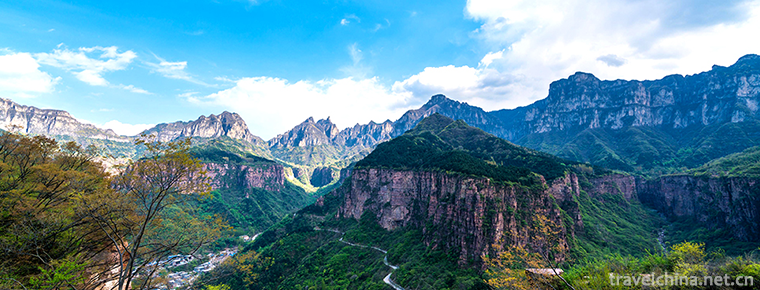
-
Holiday Beach
Holiday beach is located on the west coastal avenue of Haikou City, which is 6 kilometers long. On the left side is the verdant forest belt of ephedra, with resorts, hotels, playgrounds and so on.
Views: 320 Time 2018-12-23 -
Mangdao Mountain Han Culture Tourist Scenic Spot
Located in Yongcheng City, Henan Province, Mangdao Mountain Han Culture Tourist Area is a national AAAAA-level scenic spot which integrates landscape sightseeing.
Views: 90 Time 2019-02-07 -
Shi Bao Village
Shibaozhai, a national AAAA-level tourist attraction, a national key cultural relic protection unit, is one of the 30 best new tourist landscapes in the Three Gorges of the Yangtze River,.
Views: 97 Time 2019-02-08 -
Zhangyu Wine Culture Museum
Zhangyu Liquor Culture Museum is one of the few professional museums in the world wine industry. It is located at the original site of Zhangyu Company, Da Ma Lu, Zhifu District, Yantai City, Shandong .
Views: 169 Time 2019-03-17 -
The Making Skills of Hui Ink
Hui ink production technology, Jixi County, Shexian County, Huangshan Tunxi District, Anhui Province, local traditional handicraft, one of the national intangible cultural heritage..
Views: 81 Time 2019-05-04 -
Uygur traditional knife making skills
Xinjiang handicraft knives (Yingjisha knife, Guizi knife, etc.) are generally more than ten or twenty centimeters long. The largest is more than half a meter and the smallest is only about two inches..
Views: 152 Time 2019-06-26 -
Uzbek Ehilai and Yelai
Uzbek Ehilai and Yelai are mainly distributed in Kashgar, Shache, Yecheng and Yining, Ili Kazakh Autonomous Prefecture, Xinjiang Uygur Autonomous Region. Uzbek people have excellent music and dance cu.
Views: 120 Time 2019-06-29 -
Sugar Eggs
Laozao is a local snack, belonging to Sichuan cuisine. Laolao, a kind of wine brewing in ancient Chinese, is a Sichuan dialect, that is, boiled eggs with wine brewing. Put the mash in the pot and boil.
Views: 468 Time 2020-03-09 -
Geographical environment of Deyang
Deyang City is located in the northeast edge of Chengdu Plain, with geographical coordinates of 30 ° 31 ′ - 31 ° 42 ′ N and 103 ° 45 ′ - 105 ° 15 ′ E. Deyang borders Fucheng District of Mianyang City in the northeast, Santai County of Mianyang City in the East.
Views: 308 Time 2020-12-14 -
Deyang local culture
On April 2, 2013, the Information Office of the people's Government of Deyang City, Sichuan Province announced the city logo of Deyang to the public. Among them, "the source of ancient Shu, the city of heavy loading" has become the main logo of Deyang City.
Views: 333 Time 2020-12-14 -
Animal resources in Nanchong
There are many animals in the subtropical farmland of Nanchong, and the number of other types of animals is less. Hundreds of wild animal resources are still preserved in the city. Among the rare animals, there are two kinds of national first class protected species.
Views: 143 Time 2020-12-17

